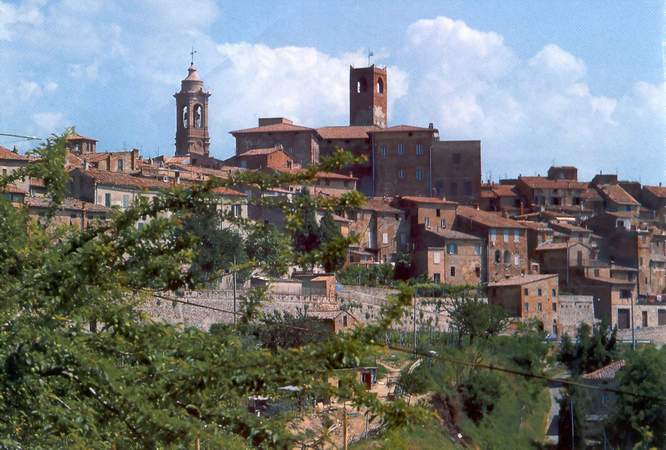Recently Jon and I spent a day in Naples and whenever we visit this amazing city we love to wander through the historic, narrow streets of the old town. Though many tourists resist the temptation to visit this area I've always found it a wonderfully atmospheric place - a bit of old Italy which welcomes visitors but refuses to compromise its heart. I've never felt unsafe there and as long as basic precautions are taken like not wearing ostentatious clothes and accessories I think any visitor will be absolutely fine and I would recommend it. There are some wonderful things to see and experience including churches, monuments, museums, fragments of Roman Naples and an amazing series of subterranean caves and passageways which have been used by the inhabitants of the city for centuries.
 |
| VIA SAN GREGORIO ARMENO - NAPLES |
Today my article is prompted by a 5 inches tall ceramic figure I can see on the window sill above my desk which I purchased in Naples during this visit for 7 euros. It came from a very distinctive narrow street in the heart of old Naples called San Gregorio Armeno which specialises in the sale of artisan made ceramic figures. It's near the 16th century Benedictine cloister which bears the same name. Lining the street are small shops with workshops behind selling figures which essentially relate to "presepe" - Italian Christmas nativities which I've written about in previous postings. Since the 17th century craftsmen have modelled and painted traditional Mary, Joseph and baby Jesus figures, shepherds, kings, sheep and all the other usual accompaniments for a Christmas crib scene and sold them all year round in the booths in this street. In Naples however presepe have, for several centuries, traditionally also featured characters from everyday life - individuals cooking, cleaning, shopping, and working - for inclusion in elaborate Bethlehem settings and the craft of making and selling these continues through to the present day.
 |
| AN ARTISAN PAINTS FIGURES IN THE VIA SAN GREGORIO, NAPLES |
Some of the shops, in recent times, have extended the tradition to include celebrity figures from contemporary life and I found it amusing to view miniature Barack Obama's, Hilary Clintons, Silvio Berlusconis and even figures of the Duke and Duchess of Cambridge with Prince George!
 |
| THE DUKE & DUCHESS OF CAMBRIDGE WITH PRINCE GEORGE PORTRAYED AS NAPLES CERAMIC FIGURES! |
The figure I chose to purchase, however, fits in to none of these categories but into another which has connections with the history of the city and one that has had an impact not just on Italian cultural life generally, but on the artistic life of Europe as a whole since the 16th century. The little white costumed figure with painted hat and black mask with tambourine in one hand is Pulcinella from the Commedia dell Arte.
 |
| "PULCINELLA" PURCHASED IN THE VIA SAN GREGORIO, NAPLES 5" tall |
The Commedia formed in the early 16th century, probably originally in the south of Italy, as a group of professional actors and actresses who made their living from staging productions in different towns and cities throughout the country. By the middle of the century troupes were performing not only in Italy but in different parts of Europe and they became especially important at the French court in the late 17th century. The term translates into English as "Comedy of Crafts" signifiying that "artigiani" or artisans were important in the productions which were usually staged outside on temporary stages. Using a combination of speech, movement, song, dance and mime - visual display was an important aspect of the events. In northern Italy the tradition of the Commedia was especially strong in Mantua, Florence and Venice where it became associated with Carnivale held between Epiphany and Ash Wednesday. Good troupes were patronised by the nobility and during carnival periods towns and cities often employed particular groups who made extra money from passing round the hat at performances.
Interestingly there were no scripts for the theatrical events - the actors and actresses relied on improvisation for the development of stagings but based on a limited range of popular themes or scenarios which appealed to the public. Characters were based on specific and easily recognizable "stock types" such as the foolish old man, the military officer full of his own pomp or the devious manipulative servant determined to see the downfall of his master. As the Commedia evolved so did the stock characters and the were given names such as Pantelone - the miserly Venetian merchant, Dottore Gratino - the pedant from Bologna and Artelino - the mischievous servant from Bergamo.
 |
| A PERFORMANCE OF THE COMMEDIA DELL 'ARTE Karel Dujardin 1657 |
 |
| "PULCINELLA IN LOVE" by TIEPOLO |
But why did I choose him rather than Harlequin or Columbine or Pantalone? Well - the literature on the subject of the Commedia all implies that it was Pulcinella who was the origin of the violent Mr Punch in the English traditional puppet show - Punch and Judy - itself based on deep rooted mythologies and which first appeared in England in 1662 and went on to be popular in France and even in the American colonies.
today
Punch and Judy shows are still a major attraction at many traditional seaside resorts and once again this story has brought back fond memories of 1950's seaside holidays spent with my Mum and Dad at Skegness in Lincolnshire and Morecambe in Lancashire - both a very long way from Naples.

